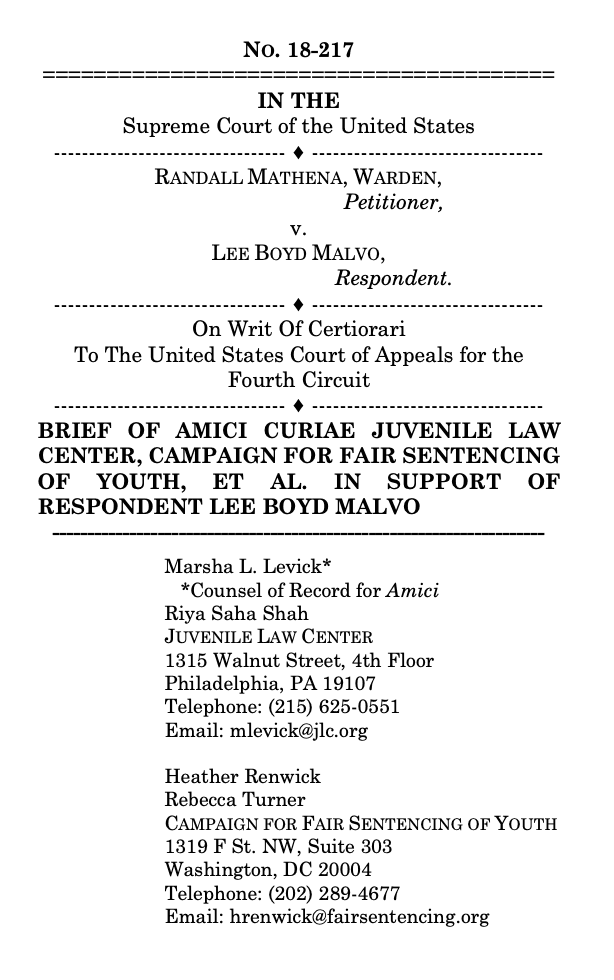
In Atkins v. Virginia, 536 U.S. 304 (2002), this Court ruled that subjecting mentally retarded individuals to the death penalty constitutes cruel and unusual punishment in violation of the Eighth Amendment. Citing developments in the law and social science that reflected a new national consensus regarding execution of the mentally retarded, the Court overruled its decision in Penry v. Lynaugh, 492 U.S. 302 (1989), that had upheld application of the death penalty to this group of individuals. A similar challenge confronts the Court in this case, with respect to the execution of youth who commit their crimes at age 16 or 17. The Court ruled in Stanford v. Kentucky, 492 U.S. 361 (1989) that such executions did not violate the Eighth Amendment. But legislative developments and an emerging powerful body of empirical research over the past fifteen years have eroded the foundation of Stanford and compel the conclusion that, under evolving standards of decency, the execution of such persons amounts to cruel and unusual punishment. In particular, such executions no longer serve the accepted purposes of capital punishment, retribution, and deterrence.
In addition to the clear legislative trend eliminating capital punishment for 16 and 17 year olds altogether and the reluctance of juries to sentence youth2 to death (which are documented in the Respondent’s brief and were central to Atkins), the well-entrenched practice in this country of circumscribing the rights and responsibilities of youth in all walks of life – from service in the armed forces and voting, to obtaining a driver’s or marriage license – has been further extended since Stanford. State legislatures have passed new laws to limit minor’s participation in activities freely open to adults, and this Court has broadened its own jurisprudence accommodating long-held views about the differences between youth and adults under the law. Premised on the diminished judgment of youth, these legal developments evidence a national determination that 16 and 17 year olds should be considered less culpable for their criminal acts than adults – a determination that undermines the retributive purpose of capital punishment.
Moreover, as in Atkins, the legislative trend to eliminate the death penalty since Stanford is all the more compelling in light of the passage of anti-crime legislation targeting youth in almost every state during this same time period. Amici argue that the legislative trend with respect to the juvenile death penalty is even more persuasive, given the unmatched phenomenon involving youth – the now-discredited “super-predator” myth, intended to demonize today’s youthful offenders as qualitatively different than earlier offenders -- which fueled this wave of transfer laws. Importantly, however, these statutes were primarily offense-, rather than offender-based, reflecting a legislative response to increased fears about public safety and frustration with the limited jurisdiction of the juvenile court. In the absence of any simultaneous attempts in the states to lower the age for juvenile court jurisdiction, there is no evidence that these transfer laws reflect new legislative views about the maturity or culpability of these youthful offenders, for the purposes of Eighth Amendment analysis.
These legal trends also have been complemented by an emerging body of social science research attesting to developmental differences between adolescents and adults that undermines the deterrent rationale of capital punishment. This path-breaking scholarship shows that 16 and 17 year olds are more likely than adults to engage in risky behavior; are more likely to consider only the immediate effects of their acts rather than the long-term consequences; and are far more susceptible to being overcome by peer pressure than adults, both in terms of how they evaluate their own behavior and in conforming their conduct to what peers are doing. And it shows that because they live in the moment, 16 and 17 year olds feel that they have less of a stake in the future. All told, this recent research confirms that 16 and 17 year olds as a class are less capable of controlling their impulses than adults, and thus are less likely than adults to be deterred from committing capital crimes by the prospect of execution.
On a separate but equally important front, social science research has recently demonstrated the special vulnerability of 16 and 17 year olds to confess to crimes that they did not commit. This research mirrors studies showing that the particular deficits of the mentally retarded make them likewise prone to giving false confessions – studies that informed the Court’s decision in Atkins. The same potential for wrongful executions of adolescents compels their exclusion from eligibility for the death penalty.